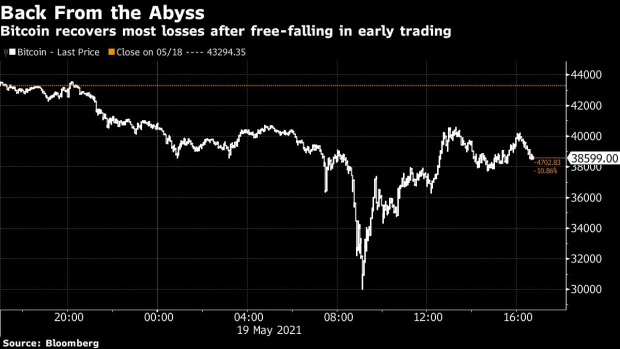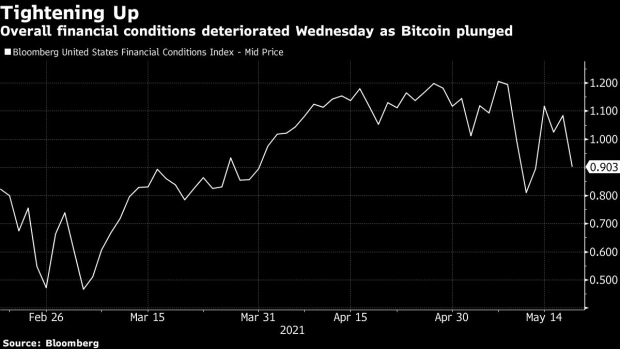May 19, 2021
Markets’ frothy edge rattled in rough day for bets on innovation
, Bloomberg News
McCreath: Crypto volatility proves you can lose money as quickly as you can make it
Wednesday had the look of a tipsy market trying to sober up.
From a crash of as much as 31 per cent in Bitcoin and even worse declines in other cryptocurrencies, to deep losses in so-called meme stocks like AMC Entertainment Holdings Inc. and GameStop Corp., the fervor for risk-taking that has defined 2021 took a major stumble.
Some of these assets were able to bounce back up, and keep on carrying on. Bitcoin cut its plunge to less than 10 per cent by the end of the day, for example. Yet there are plenty of hangovers to go around.
To put it more kindly, Michael Shaoul of Marketfield Asset Management uses the acronym HOPE for some of the stocks that have face-planted. That’s short for “highly optimistic projected earnings.” As the recovery in the economy continues to boost more cyclical stocks at the expense of speculative growth companies, he says, it creates potential for more “waves of panic” like this to roil markets. The recent broader embrace of cryptocurrencies by traditional investors only compounds the issue.“
Three years ago, when Bitcoin blew up, it really didn’t matter,” Shaoul said in an interview on Bloomberg Television. “But right now, there is real institutional money and some real wealth-management money in Bitcoin. And of course there’s a significant amount of market cap.”
The carnage was widespread across cryptocurrencies, a slump partly attributed to China reiterating that their use in transactions is forbidden in that country and partly attributed to a lingering reaction to Elon Musk’s about-face last week on accepting Bitcoin as payment for cars made by Tesla Inc.

While dip buyers spared Bitcoin from its worst day of the year, other coins suffered major losses. Tokens including Litecoin and Dash remained mired in a downturn that saw each lose more than 30 per cent, while Ether -- the second-largest crypto -- shed roughly a quarter of its value. The joke-coin Doge, which took the Internet by storm in recent weeks following a red-hot rally, lost more than 20 per cent to trade around US$0.36, according to CoinMarketCap.com. That’s down from a high above US$0.70 notched earlier this month.
Yet, the apparent role that Bitcoin’s plunge played in creating broader market-wide volatility is an alarming sign, considering the notorious volatility of the virtual currency.
The result on Wednesday was a deterioration in overall financial conditions as tracked by a Bloomberg index that measures the state of everything from equities to credit, yields and money markets, according to Medley Global Advisors macro strategist Ben Emons. That’s due in part to Bitcoin’s growing reputation as “the Boomer coin,” he wrote. In other words, it’s the one being embraced the most by the older members of the financial industry and a growing list of chief executive officers in the corporate world.
Shares of companies that have at least dipped a toe into the Bitcoin waters -- PayPal Holdings Inc., Square Inc., MicroStrategy Inc. and Tesla -- all followed the cryptocurrency lower during the day, before recovering at least partially. Cathie Wood’s ARK Innovation ETF fell as much as 4.5 per cent before recouping more than half of the loss, while Canada’s Purpose Bitcoin ETF sank as much as 22 per cent before ending the session 9 per cent lower.

“It shows that companies with direct ties to Bitcoin can attribute for a large extent to an equity selloff,” Emons said.
By the end of the day, the closing prints on the stock-market tape belied the drama that began shaking the financial world before the sun even rose over New York. The S&P 500 finished the session down 0.3 per cent, paring a drop of more than 1.6 per cent. The Nasdaq 100 Index managed to finish 0.2 per cent higher after plunging 1.7 per cent. The Cboe Volatility Index was up less than 1 to 22.18. The Renaissance IPO ETF, which had sank as much as 3.8 per cent, closed down only 0.3 per cent. And the IPOX SPAC Index of special-purpose acquisition companies lost less than 0.4 per cent
Yet, lingering quietly among all of the volatility Wednesday was a market that’s been notorious for shaking things up since long before Bitcoin came on the scene: U.S. Treasuries. Yields on the 10-year note climbed four basis points to almost 1.68 per cent on Wednesday, keeping the specter of higher interest rates alive and well as a risk to stocks.
“At the start of the year, my two biggest worries were notably higher yields and a bubble bursting in tech shares,” Jim Reid, a strategist at Deutsche Bank, wrote in a note. “As we get closer to mid-year, yields are indeed a lot higher across the globe and tech is deflating from its February peaks.”








